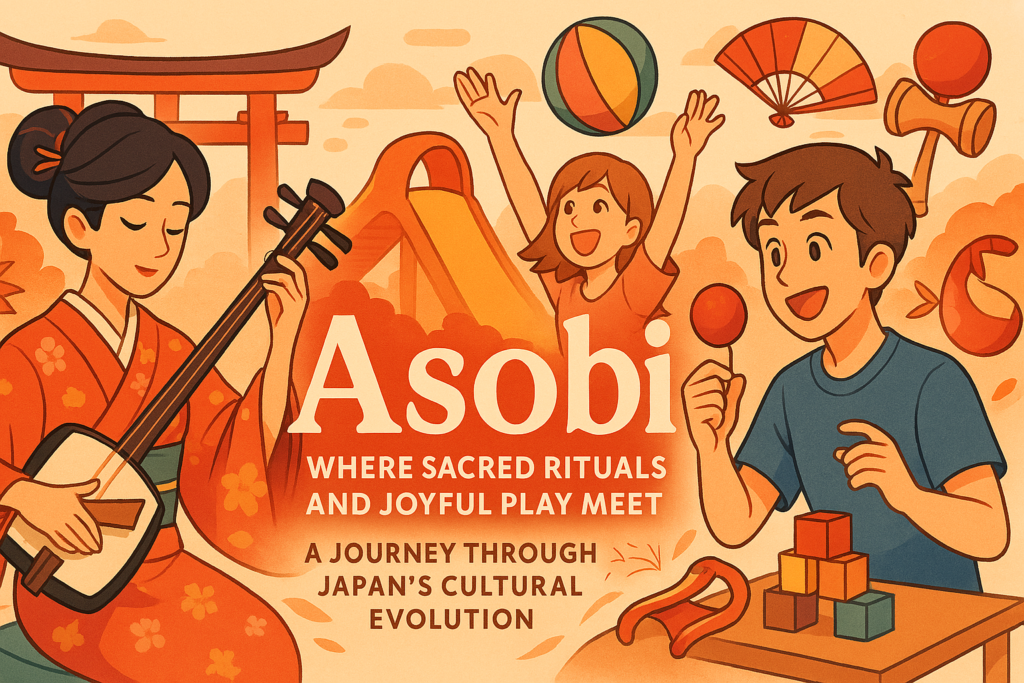Unraveling the Cultural Significance of “Asobi” in Japanese History
Have you ever wondered about the deeper meanings hidden within Japanese cultural traditions? The word “asobi” carries a rich historical significance that transcends its simple translation of “play” or “entertainment.” From ancient Shinto rituals to sophisticated artistic performances, the concept of asobi has evolved dramatically throughout Japanese history, reflecting changing social values and religious practices.
In this comprehensive guide, we’ll explore the fascinating journey of asobi from sacred ritual to entertainment art form, examining its cultural impact and linguistic importance in Japanese society.
The Origin of Asobi: Divine Roots in Japanese Mythology
The term “asobi” (遊) originates from ancient Japanese mythology, specifically from the story of the goddess Ame-no-Uzume-no-Mikoto recorded in the Kojiki, Japan’s oldest historical record.
According to the myth, when the sun goddess Amaterasu hid in a cave after being pranked by her brother Susano-no-Mikoto, the world was plunged into darkness. To lure her out, Ame-no-Uzume performed a provocative dance before the assembled gods, becoming divinely possessed and partially disrobing herself. The gods’ laughter at this performance piqued Amaterasu’s curiosity, causing her to peek out from the cave.
This divine performance is described in the Kojiki as “asobi,” which directly translates to “play” or “entertainment.” This mythological origin established asobi as a shamanic ritual with transformative power—a means of mediating between light and darkness, life and death.
The Evolution of Asobi: From Sacred Ritual to Entertainment
Asobi-be: The Sacred Priestesses
In ancient Japan during the Heian period (794-1185), women known as “asobi-be” (遊部) served as Shinto priestesses dedicated to the goddess Ame-no-Uzume. Unlike other court women who were identified by their family connections or official positions, asobi used personal names, highlighting their unique social position outside the traditional hierarchy.
These priestesses originally performed shamanistic rituals associated with funeral ceremonies, particularly for royal families. They were considered crucial for appeasing the souls of the dead and bringing renewal in times of loss. Due to their important ritual function, asobi-be were granted special privileges, including:
- Exclusive access to royal coffins during enshrinement
- Immunity from conscript labor and taxes
- Freedom to perform secret dances and incantations
Cultural Transformation After Religious Reforms
The meaning and role of asobi underwent significant transformation following the introduction of Buddhism and Confucianism to Japan in the early 8th century. With the implementation of the Taihō Reform Code in 701 and the Yōrō Code in 718, the perception of asobi-be began to shift.
As Buddhist priests (predominantly male) took over imperial funerary operations, asobi priestesses were displaced from their traditional roles. This shift forced them to adapt their traditional performance skills for survival, leading to a new cultural identity as entertainers and performers.
Want to explore Japan’s culture?
Discover Japan’s rich culture, traditions, and hidden gems with our expertly crafted guides. Get insider tips on travel, food, and history. All for free!
Imayō: The Musical Art of Asobi
As asobi women transitioned from priestesses to entertainers, they became renowned for their musical talents, particularly their performances of imayō songs. These songs covered a wide range of topics that appealed to diverse audiences:
- Buddhist doctrines and figures
- Nature themes (trees, birds, insects)
- Everyday life vignettes
- Religious and spiritual concepts
The imayō performances, accompanied by small drums, became immensely popular in Heian court culture. This popularity helped asobi maintain a distinct identity from ordinary prostitutes (yahochi). As noted in the Wamyō Ruijushō dictionary from the 930s: “Those who wander about in the daytime are called asobi, while those who wait until nighttime and then engage in wanton sex (inbon) are called yahochi.”
The Social Organization of Asobi
Asobi communities developed sophisticated social structures, typically centered around waterways like the Yodo River, which served as the main travel route to the capital of Heian-kyō. By the late 11th century, asobi had established colonies in places like Eguchi, with dwellings similar to travelers’ inns along highways.
Their social organization included:
- Leadership by a headmistress (chōja, so, or mune)
- Hereditary succession through mother and daughter
- Team performances on boats with defined roles
- Worship of deities like Hyakudaifu for business prosperity
Some asobi achieved remarkable social mobility, becoming landowners—a privilege normally reserved for the upper classes of Heian society.
Cultural Legacy and Historical Significance
The cultural impact of asobi extended beyond entertainment, influencing Japanese literature, music, and social customs. Emperor Go-Shirakawa (1127-1192) was famously devoted to the art of imayō, spending years cultivating his skills and even taking an asobi named Tamba-no-tsubone as a secondary wife.
His dedication to preserving this art form resulted in the compilation of the Ryōjin Hishō (“Secret Selection of Music”), which took two decades to complete. This collection remains one of the few historical resources that captures the perspectives of women from both elite and lower social classes.
Like other aspects of Japanese culture and language (such as conjunctions like “soshite” or essential phrases), understanding asobi offers valuable insights into how Japanese society has evolved over the centuries.
Modern Interpretations of Asobi
Today, the word “asobi” in modern Japanese primarily means “play” or “recreation,” having evolved considerably from its ancient religious connotations. You might encounter it in common phrases like:
- “Asobi ni iku” (遊びに行く) – To go out for fun/to play
- “Kodomo no asobi” (子供の遊び) – Children’s play
- “Asobi kokoro” (遊び心) – Playful spirit or playfulness
The concept of asobi continues to evolve in contemporary Japanese culture, now encompassing everything from traditional games to modern entertainment forms. Its journey from sacred ritual to common recreation reflects the dynamic nature of language and culture.
Enhance Your Japanese Language Journey
Understanding cultural concepts like “asobi meaning” provides valuable context for Japanese language learners. If you’re interested in deepening your knowledge of Japanese language and culture, check out our comprehensive learning guides where you can access free resources to accelerate your language journey.
Just as mastering the water kanji (水) or learning to express appreciation with “otsukare” enhances your Japanese fluency, grasping cultural concepts like asobi adds depth to your understanding of Japan’s rich heritage.
FAQs About Asobi Meaning and Cultural Significance
What does asobi mean in Japanese?
Asobi in Japanese means “play” or “entertainment.” It originated as a term for sacred shamanic rituals but has evolved to refer to recreational activities in modern usage.
Were asobi women considered prostitutes in ancient Japan?
While asobi women did accept gifts for sexual favors, they were culturally distinct from ordinary prostitutes (yahochi) because of their artistic talents, particularly their musical performances of imayō songs.
How did Buddhism change the role of asobi in Japanese society?
Buddhism’s introduction to Japan led to male Buddhist priests taking over imperial funeral ceremonies, forcing asobi priestesses to transition from religious roles to entertainment professions, fundamentally changing their social position.
Did any notable historical figures interact with asobi?
Yes, several emperors and nobles were known to have relationships with asobi, including Emperor Go-Shirakawa, who not only learned imayō from asobi women but also married one named Tamba-no-tsubone.
How is the concept of asobi relevant to modern Japanese culture?
The evolution of asobi from sacred ritual to everyday recreation reflects Japan’s cultural transformation over centuries. Today’s understanding of “play” in Japanese society carries subtle influences from these historical traditions.
Whether you’re planning a trip to Japan in October or simply fascinated by Japanese cultural history, understanding concepts like “asobi meaning” adds richness to your appreciation of this remarkable civilization. The story of asobi—its divine origins, cultural transformations, and lasting legacy—exemplifies how language and culture continuously evolve while maintaining connections to their ancient roots.
Love Japan? Stay in the Loop!
Get the best of Japan straight to your inbox: language, culture & travel insights!




